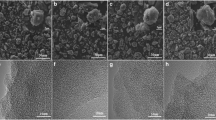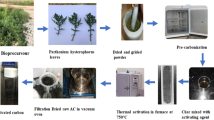Abstract
We present a methodology to enhance the electrical capacitance of activated carbon (AC) electrodes based on the introduction of electrically charged defects through argon plasma processing. Extensive characterization using electrochemical techniques incorporating cyclic voltammetry, constant current charge/discharge, and electrical impedance spectroscopy indicated a close to seven-fold increase in capacitance with respect to untreated AC electrodes, not subject to plasma processing.
Similar content being viewed by others
References
Chmiola, J., Yushin, G., Gogotsi, Y., Portet, C., Simon, P., & Taberna, P. L. (2006). Anomalous increase in carbon capacitance at pore sizes less than 1 nanometer. Science, 313(5794), 1760–1763.
Karakaya, M., Zhu, J., Raghavendra, A. J., Podila, R., Parler Jr, S. G., Kaplan, J. P., & Rao, A. M. (2014). Roll-to-roll production of spray coated N-doped carbon nanotube electrodes for supercapacitors. Applied Physics Letters,105(26), 263103.
Okajima, K., Ohta, K., & Sudoh, M. (2005). Capacitance behavior of activated carbon fibers with oxygen-plasma treatment. Electrochimica Acta, 50(11), 2227–2231.
Hoefer, M., & Bandaru, P. (2013). Electrochemical Characteristics of Closely Spaced Defect Tuned Carbon Nanotube Arrays. Journal of The Electrochemical Society, 160(6), H360–H367.
Narayanan, R., Yamada, H., Karakaya, M., Podila, R., Rao, A. M., & Bandaru, P. R. (2015). Modulation of the electrostatic and quantum capacitances of few layered graphenes through plasma processing. Nano letters. DOI: 10.1021/acs.nanolett.5b00055
Xu, G., Zheng, C., Zhang, Q., Huang, J., Zhao, M., Nie, J., ... & Wei, F. (2011). Binder-free activated carbon/carbon nanotube paper electrodes for use in supercapacitors. Nano Research, 4(9), 870–881.
Stoller, M. D., & Ruoff, R. S. (2010). Best practice methods for determining an electrode material’s performance for ultracapacitors. Energy & Environmental Science, 3(9), 1294–1301.
Conway, B. E. (1999). Electrochemical supercapacitors. 53 – 57, 486 – 496.
Bard, A. J., & Faulkner, L. R. (2001). Electrochemical methods: principles and applications. Electrochemical Methods: Principles and Applications. 386 – 428.
Author information
Authors and Affiliations
Rights and permissions
About this article
Cite this article
Muriel, M.L., Narayanan, R. & Bandaru, P.R. Increasing Energy Storage in Activated Carbon based Electrical Double Layer Capacitors through Plasma Processing. MRS Online Proceedings Library 1773, 15–20 (2015). https://doi.org/10.1557/opl.2015.573
Published:
Issue Date:
DOI: https://doi.org/10.1557/opl.2015.573




